The Areas Issuing the Most Fly-Tipping Fines in England
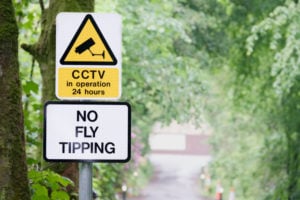
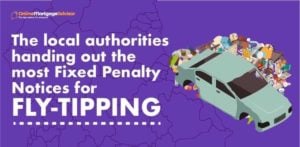
Despite being illegal, England’s local authorities recorded a whopping 975,631 fly-tipping incidents in 2019/20. With the environmental implications of dumping waste well-known, local authorities up and down the country are trying to tackle the troublesome offence, some with greater success than others.
In order to determine which local authorities and regions are punishing fly-tipping the most and tackling the issue head-on, we analysed official Government data and calculated what percentage of incidents result in Fixed Penalty Notices (FPN). From this, we could identify which local authorities and regions are doing the most to combat the waste-related offence.
The local authority areas doing the most to combat fly-tipping in England
When it comes to illegal dumping, better known as fly-tipping, some local authorities take a tougher stance than others, issuing Fixed Penalty Notices for reported incidents of the offence. But which local authority areas are doing the most to combat it?
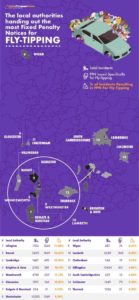
Islington, in London, was revealed to be the most responsive towards fly-tipping incidents in 2019/20, with almost 72% of incidents recorded in this area resulting in Fixed Penalty Notices. In fact, of the 1,764 fly-tipping incidents recorded, there were 1,268 Fixed Penalty Notices issued, rendering Islington as the local authority taking the most action against fly-tipping offences.
Meanwhile, Barnet was found to be the second most responsive local authority when it came to issuing Fixed Penalty Notices for fly-tipping. The local authority, which is also in London, recorded 3,420 fly-tipping incidents in 2019/20 and issued 1,869 Fixed Penalty Notices. This means that just over half (54.65%) of fly-tipping incidents in the area resulted in a fine, making Barnet one of the most pro-active local authorities in tackling fly-tipping offences.
The local authority handing out the third highest number of Fixed Penalty Notices for fly-tipping in 2019/20 was Cambridge. In total, the area recorded 1,487 fly-tipping incidents, with 490 Fixed Penalty Notices issued for the offence – that’s just under a third (32.95%) of fly-tipping incidents. This means that Cambridge was one of the local authorities taking the most action against the illegal dumping in England.
Governmental data shows that the seaside city of Brighton and Hove is the fourth most responsive local authority against fly-tipping. The local authority recorded 2,100 incidents in 2019/20, and issued 381 Fixed Penalty Notices, which means to 18.14% of fly-tipping incidents resulted in a Fixed Penalty Notice
Rounding off the top five is Wandsworth, with the local authority having the fifth highest percentage of fly-tipping incidents resulting in a Fixed Penalty Notice in 2019/20. Wandsworth suffered 4,745 fly-tipping incidents in total and gave 529 Fixed Penalty Notices in response (11.15%).
The regions taking the most action against fly-tipping
After identifying the local authorities issuing the most Fixed Penalty Notices in 2019/20, we sought to find out which regions in England taking the most action against fly-tipping offences.
Interestingly, we found that fewer than 3% of fly-tipping incidents resulted in a Fixed Penalty Notice in every region. In fact, overall, only 1.38% of all fly-tipping incidents recorded in England between 2019/20 resulted in a Fixed Penalty Notice. However, certain regions were still more responsive than others when it came to issuing Fixed Penalty Notices for the offence.
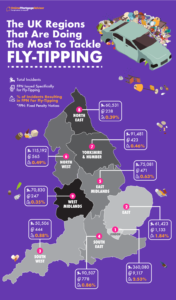
London was found to be the most responsive region overall, with 2.53% of London-based fly-tipping incidents resulting in a Fixed Penalty Notice. To be specific, there were 360,080 recorded incidents of fly-tipping in the region, with 9,117 Fixed Penalty Notices issued during 2019/20.
The North West ranked as the second most responsive region, issuing 565 Fixed Penalty Notices for the 115,192 fly-tipping incidents recorded. This was equivalent to 0.49% of recorded incidents leading to a Fixed Penalty Notice, which was the second highest percentage. Despite this, the North West was also the region with the second highest number of fly-tipping incidents, with Liverpool, Manchester, Rochdale, and Salford recording the highest numbers of fly-tipping incidents in the region, respectively.
Similarly, Yorkshire and the Humber was the third most responsive region when it came to issuing Fixed Penalty Notices for fly-tipping in 2019/20, but also suffered the third largest number of fly-tipping incidents in general. Yorkshire and The Humber reported 91,481 incidents and issued 423 Fixed Penalty Notices between 2019/20, which means that 0.46% of these incidents were met with a penalty.
The areas with the most fly-tipping incidents in England
We also looked into the number of fly-tipping incidents that take place in each local authority and region, ranking these from most to least, to discover which area in England is home to the worst offenders of illegal waste dumping.
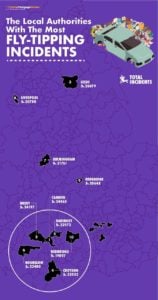
The local authority reporting the highest number of fly-tipping incidents in England overall is Camden, with 34,465 in total, which is just under 10% of the capital’s total fly-tipping incidents. Camden was followed by Brent in second, with 268 fewer fly-tipping incidents.
Aside from Leeds, which recorded the third highest number of fly-tipping incidents (26,079), the top six local authorities recording the highest numbers of fly-tipping incidents in England were all located in London: Camden (34,465), Brent (34,197), Croydon (25,532), Haringey (22,972) and Hounslow (22,480).
Meanwhile, Birmingham recorded the eighth highest total of fly-tipping incidents with 21,761, and it was shortly followed by Liverpool, who recorded 20,780 fly-tipping incidents in total.
Methodology:
- To do this, OnlineMortgageAdvisor.co.uk sourced the Government Official Fly-Tipping Incidents and Actions Taken in England data. The source provided data for the period 2019/2020.
- We then focused on the percentage of incidents resulting in fixed penalty notices specifically for fly-tipping to uncover which local authorities were doing the most.
- The data was then split into regions, tallied up and ranked from most to least in percentage of incidents resulting in fixed penalty notices specifically for fly-tipping.
- Any local authorities with fewer than 100 incidents recorded of fly-tipping in the government data were excluded from the analysis.
